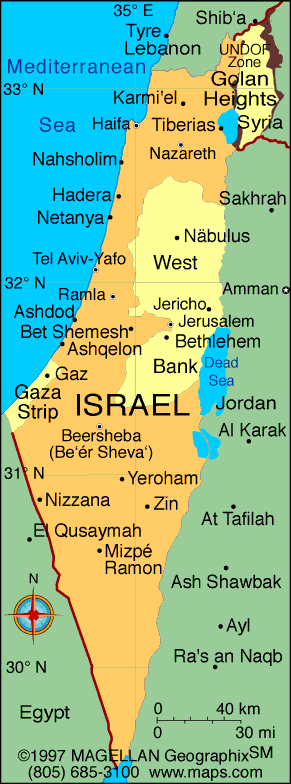ISRAEL

Geography: Israel, slightly larger than Massachusetts, lies at the eastern end of the Mediterranean Sea. It is bordered by Egypt on the west, Syria and Jordan on the east, and Lebanon on the north. Its maritime plain is extremely fertile. The southern Negev region, which comprises almost half the total area, is largely a desert. The Jordan, the only important river, flows from the north through Lake Hule (Waters of Merom) and Lake Kinneret (also called Sea of Galilee or Sea of Tiberias), finally entering the Dead Sea 1,349 ft (411 m) below sea level—the world's lowest land elevation.
Government: Parliamentary democracy.
History: Palestine, considered a holy land by Jews, Muslims, and Christians, and homeland of the modern state of Israel, was known as Canaan to the ancient Hebrews. Palestine's name derives from the Philistines, a people who occupied the southern coastal part of the country in the 12th century B.C.
A Hebrew kingdom established in 1000 B.C. was later split into the kingdoms of Judah and Israel; they were subsequently invaded by Assyrians, Babylonians, Egyptians, Persians, Romans, and Alexander the Great of Macedonia. By A.D. 135, few Jews were left in Palestine; most lived in the scattered and tenacious communities of the Diaspora, communities formed outside Palestine after the Babylonian exile. Palestine became a center of Christian pilgrimage after the emperor Constantine converted to that faith. The Arabs took Palestine from the Byzantine empire in 634–640. Interrupted only by Christian Crusaders, Muslims ruled Palestine until the 20th century. During World War I, British forces defeated the Turks in Palestine and governed the area under a League of Nations mandate from 1923.
Government: Parliamentary democracy.
History: Palestine, considered a holy land by Jews, Muslims, and Christians, and homeland of the modern state of Israel, was known as Canaan to the ancient Hebrews. Palestine's name derives from the Philistines, a people who occupied the southern coastal part of the country in the 12th century B.C.
A Hebrew kingdom established in 1000 B.C. was later split into the kingdoms of Judah and Israel; they were subsequently invaded by Assyrians, Babylonians, Egyptians, Persians, Romans, and Alexander the Great of Macedonia. By A.D. 135, few Jews were left in Palestine; most lived in the scattered and tenacious communities of the Diaspora, communities formed outside Palestine after the Babylonian exile. Palestine became a center of Christian pilgrimage after the emperor Constantine converted to that faith. The Arabs took Palestine from the Byzantine empire in 634–640. Interrupted only by Christian Crusaders, Muslims ruled Palestine until the 20th century. During World War I, British forces defeated the Turks in Palestine and governed the area under a League of Nations mandate from 1923.

Map of Israel
President-elect:
Reuven Rivlin (2014)
Prime
Minister: Benjamin Netanyahu (2009)
Land area: 7,849 sq mi (20,329 sq km);
total area: 8,019 sq mi (20,770 sq km)
Population (2014 est.): 7,821,850 (growth
rate: 1.46%); birth rate: 18.44/1000; infant mortality rate: 3.98/1000;
life expectancy: 81.28
Capital and largest city (2009 est.):
Jerusalem, 791,000 Note: Israel proclaimed
Jerusalem as its capital in 1950, but the U.S., like nearly all other
countries, maintains its embassy in Tel Aviv.
Other large cities: Tel Aviv-Yafo 3.381 million; Haifa 1.054 million
Monetary
unit: Shekel
National
name: Medinat Yisra'el
Languages:
Hebrew (official), Arabic, English
Ethnicity/race:
Jewish 75.1% (of which Israel-born 73.6%,
Europe/America/Oceania-born 17.9%, Africa-born 5.2%, Asia-born 3.2%),
non-Jewish 24.9% (mostly Arab) (2012 est.)
Religions:
Jewish 75.1%, Muslim 17.4%, Christian 2%, Druze 1.6%, other 3.9% (2012 est.)
National Holiday:
Independence Day, April or May 14
Literacy rate: 97% (2004 est.)
Economic summary: GDP/PPP (2014 est.):
$273.2 billion; per capita $36,200. Real growth rate: 3.3%.
Inflation: 3.9%. Unemployment: 1.7%. Arable land:
13.68%. Agriculture: citrus, vegetables, cotton; beef, poultry,
dairy products. Labor force: 3.493 million; agriculture 1.65%;
industry 18.1%; services 80.3% (2012). Industries:
high-technology projects (including aviation, communications,
computer-aided design and manufactures, medical electronics, fiber
optics), wood and paper products, potash and phosphates, food,
beverages, and tobacco, caustic soda, cement, construction, metals
products, chemical products, plastics, diamond cutting, textiles,
footwear. Natural resources: timber, potash, copper ore,
natural gas, phosphate rock, magnesium bromide, clays, sand.
Exports: $62.32 billion (2012 est.): machinery and
equipment, software, cut diamonds, agricultural products, chemicals,
textiles and apparel. Imports: $67.03 billion (2013
est.): raw materials, military equipment, investment goods, rough
diamonds, fuels, grain, consumer goods. Major trading partners:
U.S., Belgium, Hong Kong, Germany, Switzerland, UK, China
(2006).
Communications: Telephones:
main lines in use: 3.594 million (2012); mobile cellular 9.225
million (2012). Broadcast media: state
broadcasting network, operated by the Israel Broadcasting Authority
(IBA), broadcasts on 2 channels, one in Hebrew and the other in Arabic; 5
commercial channels including a channel broadcasting in Russian, a
channel broadcasting Knesset proceedings, and a music channel supervised
by a public body; multi-channel satellite and cable TV packages provide
access to foreign channels; IBA broadcasts on 8 radio networks with
multiple repeaters and Israel Defense Forces Radio broadcasts over
multiple stations; about 15 privately owned radio stations; overall more
than 100 stations and repeater stations (2008). Internet hosts: 2.483 million (2012).
Internet users: 4.525 million (2009).
Transportation: Railways: total: 975 km
(2008). Roadways: total: 18,566 km; paved: 18,566 km (including
449 km of expressways) (2011). Ports and terminals:
Ashdod, Elat (Eilat), Hadera, Haifa. Airports: 47 (2013).
International disputes: West Bank and Gaza
Strip are Israeli-occupied with current status subject to the
Israeli-Palestinian Interim Agreement - permanent status to be
determined through further negotiation; Israel continues construction
of a "seam line" separation barrier along parts of the Green Line and
within the West Bank; Israel announced its intention to pull out
Israeli settlers and withdraw from the Gaza Strip and four settlements
in the northern West Bank in 2005; Golan Heights is Israeli-occupied
(Lebanon claims the Shab'a Farms area of Golan Heights); since 1948,
about 350 peacekeepers from the UN Truce Supervision Organization
(UNTSO) headquartered in Jerusalem monitor ceasefires, supervise
armistice agreements, prevent isolated incidents from escalating, and
assist other UN personnel in the region.
-------------------- o --------------------
No comments:
Post a Comment